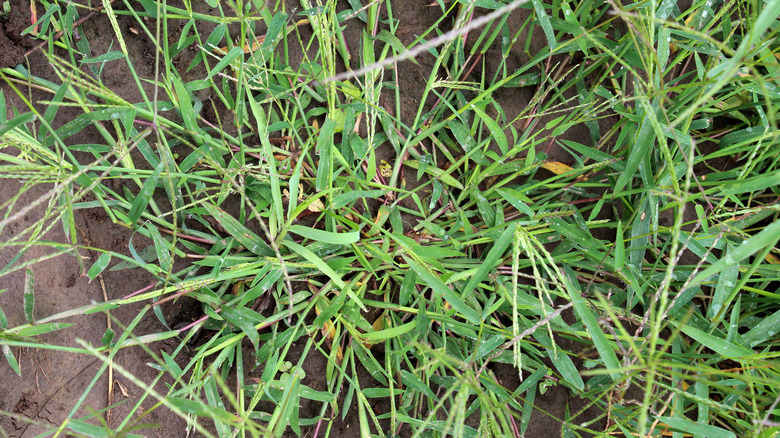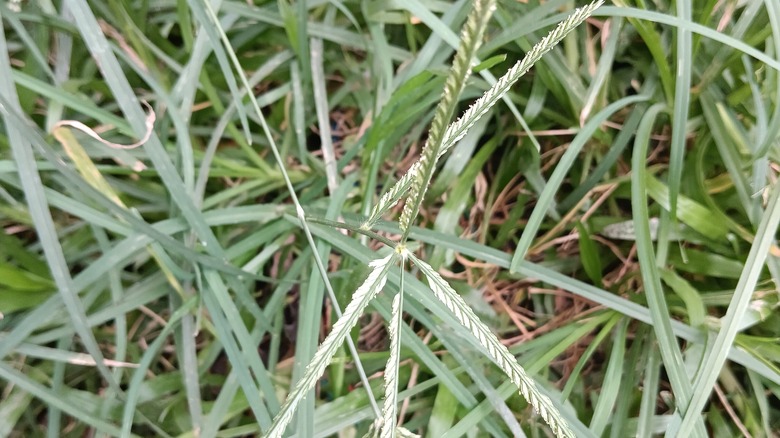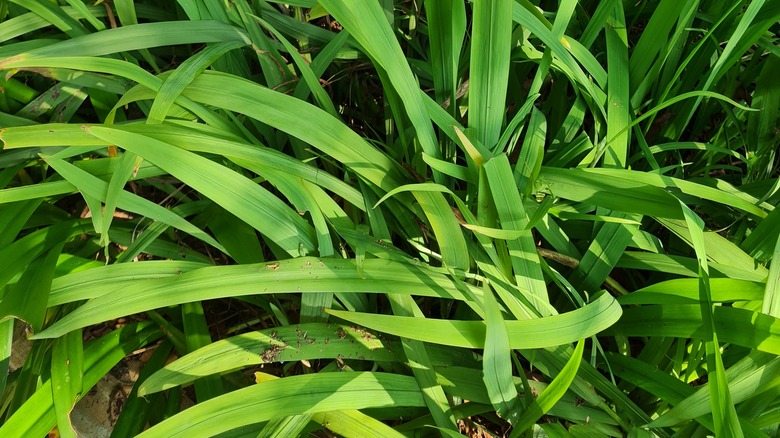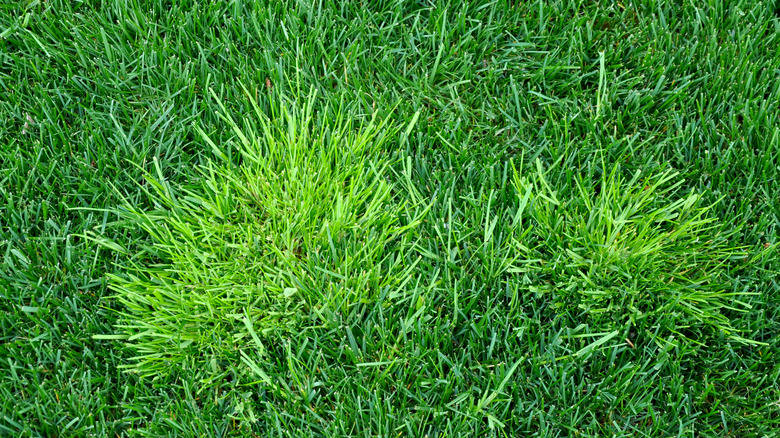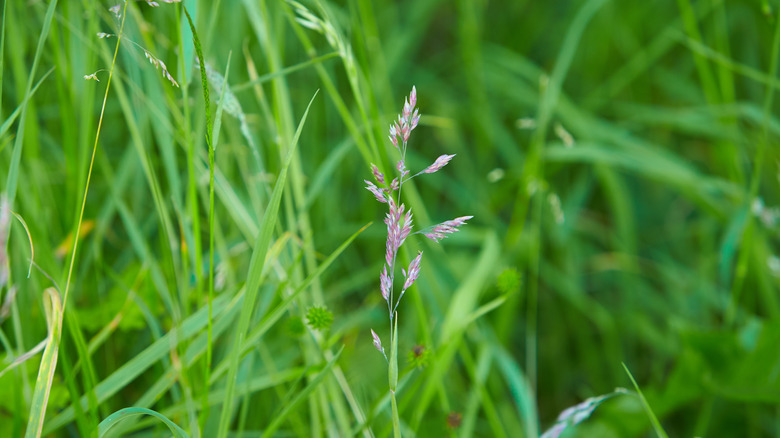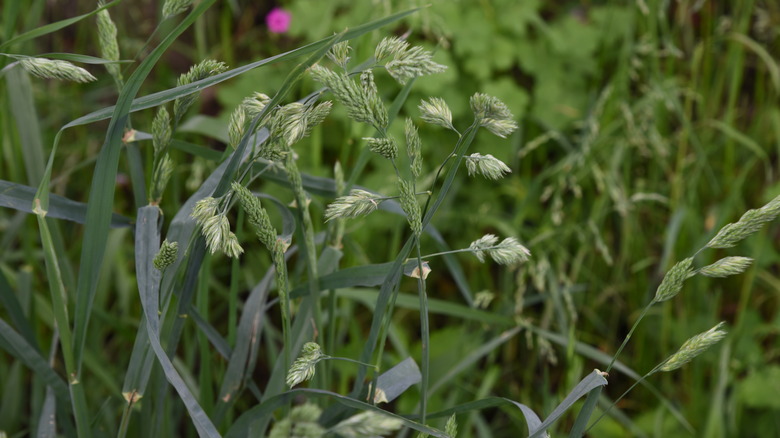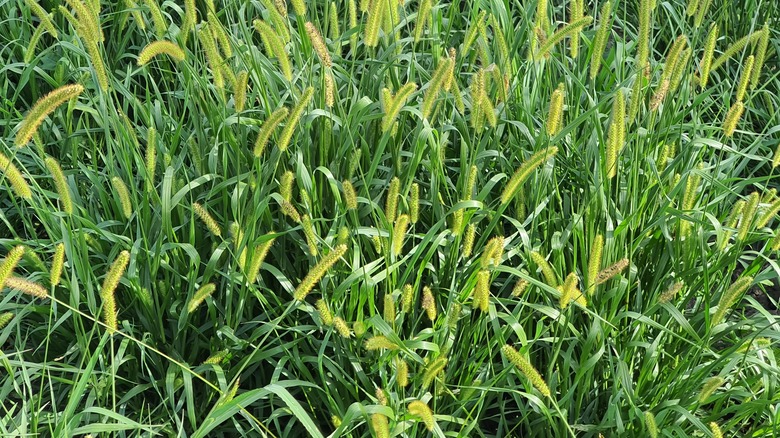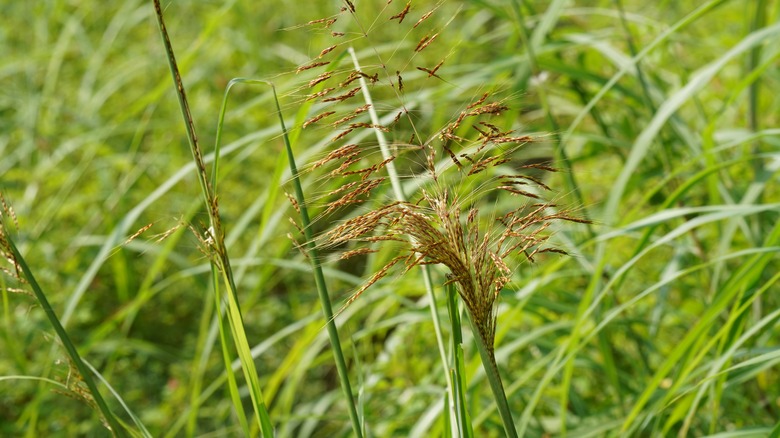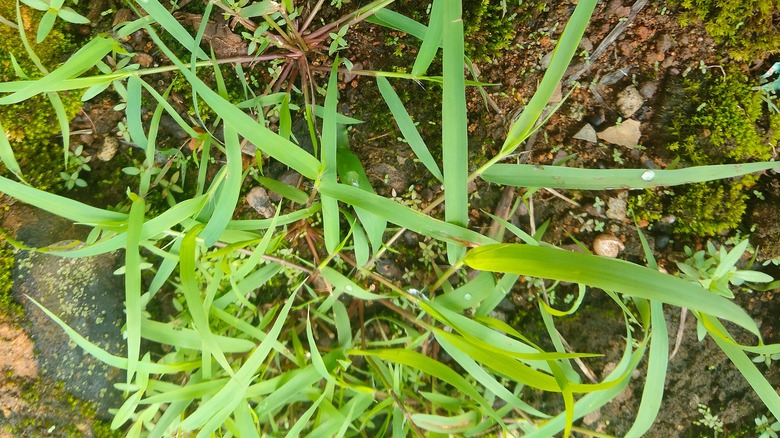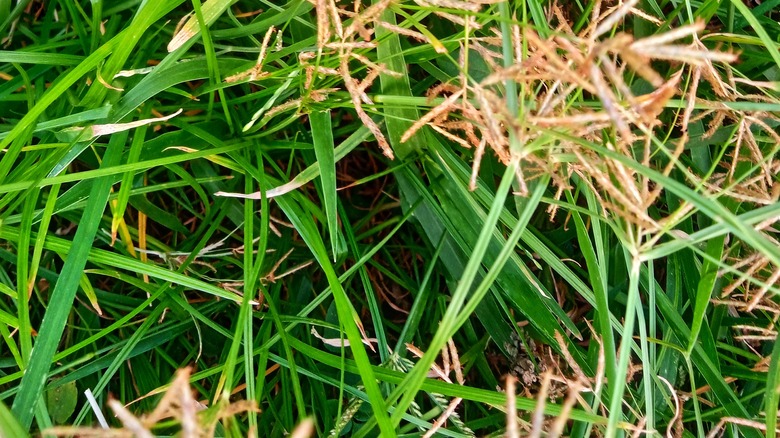How To Spot & Get Rid Of These 9 Crabgrass Look-Alikes
Crabgrass (Digitaria spp.) is a common weed that gardeners hate to see on their lawns. The pesky plant is widespread across North America, but that doesn't mean you should jump to conclusions when you spot tufts of a grassy weed among your turf. There are many other crabgrass doppelgangers that could easily fool you into thinking they might be the real deal. Although identifying weeds probably doesn't sound like an enjoyable pastime, this is actually a really important aspect of gardening. Being able to distinguish which invasive plant is growing in your yard means you'll be able to find out the best ways to deal with it.
Not all weeds respond to the same types of treatment. Knowing which one you have is crucial in understanding the best course of action to remove it and stop it from making a repeat appearance. Some, like crabgrass, can be effectively controlled with pre-emergent herbicides, while others, like orchardgrass, won't respond to this kind of approach. The best time of year to get rid of your lawn's weeds can differ depending on the species of weed. Want to learn how to tell your crabgrass from your goosegrass and quackgrass? We've got you covered.
Combat goosegrass before it appears with pre-emergent herbicides
Crabgrass and goosegrass (Eleusine indica (L.) Gaertn.) look very alike, and the challenge of differentiating them is made even harder by the fact that they also act alike. Both of these weeds are warm-season plants that will make an appearance in the lawn in spring and become well-established by late summer. The first frost of fall will kill them, but not before they have developed thousands of seeds that can hide in the soil for many years and suddenly make a comeback. The best way to identify goosegrass is to inspect the leaves. Goosegrass leaves have a silver tint, which has given rise to the common name 'silver crabgrass'. The leaves of goosegrass will also be more slender than crabgrass, and be a paler color at the base.
Crabgrass has a threadlike root system which means these weeds can be pulled up by hand quite easily. Unfortunately, this is where the two plants differ. Goosegrass has a strong taproot, making hand-removal of this weed quite difficult. The best way to control goosegrass in your lawn is with a pre-emergent herbicide. These products work to prevent the seeds from ever germinating. Be sure to select a pre-emergent herbicide specifically formulated for use on goosegrass because one weed-killer does not fit all. Follow the manufacturer's instructions, paying close attention to the best time of year for application.
Dense turf is the best defense against quackgrass
Like crabgrass, quackgrass (Elymus repens) has a green lawn-like appearance that can make it difficult to identify. The key differences to note between these two weeds are the quality and color of the leaves and the direction of growth. Crabgrass takes on a more uniform, rosette shape, while quackgrass appears more unruly. The leaves of quackgrass have a more ragged appearance and blue-green color. As the weeds grow, crabgrass will spread along the ground, while quackgrass can stand up to heights of 4 feet. As a cool-season perennial, you can also differentiate crabgrass and quackgrass by their response to low temperatures. Crabgrass will not survive the first frost, while quackgrass continues to grow through all seasons.
Quackgrass spreads via underground rhizomes, which makes it both very aggressive and also a nightmare to remove by hand. Pre-emergent herbicides won't work on quackgrass because it is a perennial. You can use non-selective herbicides on quackgrass, but these can also harm desirable lawn species, so they aren't ideal. Instead, the easiest way to get rid of quackgrass is to focus your efforts on making your lawn as healthy as it can be. A dense and thriving lawn will limit the access quackgrass has to light and moisture, helping to suppress it as well as preventing it from germinating.
Keep gardening tools clean to prevent annual bluegrass growth
Bluegrass (Poa annua) and crabgrass are both grassy weeds that grow in clumps, so they can be difficult to tell apart. As you might expect from the name, bluegrass has a slightly bluish tone, so consider the color when determining if the weed in your garden is bluegrass or crabgrass. Crabgrass has an apple-green hue, while bluegrass is more blue-green. The seedheads of bluegrass are also easy to spot, appearing as early into the year as spring, while crabgrass does not display its seedheads.
Fortunately, the root systems of bluegrass weeds are shallow and fragile, so you can pull them out quite easily by hand. The main issue with bluegrass is that it is a very productive seeder, so the weeds spread and return seemingly endlessly. To disrupt the cycle of bluegrass weeds, your best means of defense is prevention. One way to stop bluegrass from spreading is to properly clean your garden equipment after each use, since viable seeds can cling to parts of mowers and other tools, only to be reintroduced to the lawn the next time they are used. Additionally, aim to improve the health of your lawn with irrigation and fertilizer so that the bluegrass weeds cannot compete.
Force tall fescue out of your lawn by digging it up
Tall fescue (Festuca arundinacea) and crabgrass are both grassy weeds that appear in lawns, and the fact that they are very similar in color makes them tricky to differentiate. You can usually spot both of these weeds amongst healthy grass because they are a light green color. To understand which of the troublesome plants you have in your lawn, you'll need to investigate in spring. As a perennial, tall fescue does not die back in winter, unlike crabgrass which fails at the first frost. This means that in spring, crabgrass should not yet have made an appearance, while tall fescue will be well on its way to forming large patches. Essentially, if you can see this weed in spring, it isn't crabgrass.
The best way to rid tall fescue from your lawn is simply to dig it up. Use a shovel and excavate the top few inches of soil around the weed to ensure all of the roots are removed. Think twice before adding these common weeds to your compost pile, unless you want to see them reappear in your garden later down the line. Instead, dispose of them properly with other garden waste, and fill the hole you have created with fresh soil, then apply lawn seed. If tall fescue has spread to the point that manual excavation isn't going to work, you can use nonselective herbicides. Just remember that these will also kill desirable grasses alongside the weeds.
Fertilize your lawn to help keep orchardgrass at bay
Orchardgrass (Dactylis glomerata) is a cool-season weed that produces leaves with a similar look to crabgrass. Though both of these weeds share a grassy look, they can usually be distinguished by their growth habit. Crabgrass grows parallel to the ground and will spread across the lawn, while orchardgrass grows in an upright manner. Orchardgrass is also a perennial, so unlike crabgrass, you might spot it on your lawn through spring.
Orchardgrass has a strong root system, which means controlling it manually isn't an easy task. If you only have a few patches of orchardgrass causing an issue in your lawn, you could dig it up but be sure to reach a depth of at least 4 inches to fully remove all of the roots. A better solution is to strengthen the health of your lawn to effectively strangle out weeds. Do this by applying a nitrogen fertilizer at the appropriate times of year to improve the condition of your turf. The best time to use fertilizer for your lawn depends on various factors, such as your local climate, and the variety of grass you are growing.
Proper lawn fertilization can help stave off yellow and green foxtail
Yellow foxtail (Setaria pumila (Poir.) Roem. and Schult) and green foxtail (Setaria viridis (L.) Beauv.) can appear very similar to crabgrass before the seedheads arrive, which can make them tricky to distinguish earlier in the season. However, once the seedheads make an appearance at any time from July to September, foxtail weeds are easy to spot. They produce showy, bushy seedheads that look like the tail of a fox, hence the common name. By contrast, crabgrass seedheads are less obvious to spot, with a slender and inconspicuous appearance.
Foxtail is fairly easy to manage when there are only a handful of examples on the lawn. These can be manually removed and disposed of. If the infestation is more severe, the best means of management is to improve the density of the desirable turf. This will help to strangle out weeds. To grow a healthy lawn, focus on proper fertilization and irrigation practices. This can include using the correct fertilizer at the appropriate times, and ensuring the soil has the right amount of water at different times of year.
Integrated management is essential for infuriating Johnsongrass weeds
Much like crabgrass, Johnsongrass (Sorghum halepense) is a weed that forms clumps of grass-like leaves. The key difference between these two problematic plants is that crabgrass is an annual while Johnsongrass is a perennial. This means crabgrass cannot survive through cold winters, and instead dies back each fall to begin the lifecycle again each spring. By contrast, Johnsongrass can continue to grow all year round. To figure out whether your willful weed is Johnsongrass or crabgrass, consider how it appears in spring. Johnsongrass will be thriving, while crabgrass should not yet be evident in lawns. If you have any livestock it's especially important to differentiate between these two weeds, because Johnsongrass can be poisonous to some animals if ingested.
Johnsongrass is known for being particularly difficult to get rid of, so in order to banish this weed from your yard you'll need to attack it on all fronts. Use pre-emergent herbicides to prevent any seeds in the soil from germinating, and use nonselective herbicides on existing Johnsongrass. You can also manually dig up Johnsongrass clumps, making sure to entirely remove the whole root system. When mowing, use low settings to remove as much of the upper sections of the plant as possible and to prevent flowers from forming. No flowers means no seeds, so this is an important step in interrupting the lifecycle of this annoying plant.
Use nimble hands to pull up nimblewill weeds
Nimblewill (Muhlenbergia schreberi J.F. Gmel.) is a grassy weed, just like crabgrass. It can be challenging to differentiate these two plants, not only because of their comparable appearance but also because they behave in a similar manner. Despite being a perennial, nimblewill goes dormant in winter, taking on the look of dead grass like crabgrass. It will spring back to life in warmer weather, and develop seedheads late in the summer. To identify nimblewill, look for wiry stems and a gray-green leaf color.
Once nimblewill is well-established it can be a struggle to manage. Though a dense and healthy lawn will go some way to controlling the spread of nimblewill, it won't eliminate the issue. Instead, aim to remove any clumps of nimblewill by hand, digging several inches beneath the soil to remove as much of the roots as possible. You can also use nonselective herbicides to kill these weeds but bear in mind that these can be detrimental to the healthy and desirable turf growing around the weeds.
Give your turf the edge over nutsedge with proper practices
Unlike crabgrass, nutsedge (Cyperus spp.) is a perennial weed. However, it can look like an annual because the above-ground parts of the plant die back over winter. What gardeners can't see, is that the underground tubers and rhizomes remain alive and store energy through the colder months, ready to send out new growth the following spring. They can be identified when their seedheads form, which appear almost like dainty flowers. The color of the seedheads might be purple or yellow, depending on the species of nutsedge.
Nutsedge is notorious for being difficult to manage. It is an enormously aggressive and vigorous grower, that usually requires a long-term, sustained effort to get it under control. Since the tubers and rhizomes can bury themselves as deep as 14 inches below the soil surface, digging them up isn't always a practical solution, though it can be attempted if the nutsedge isn't yet out of control. To drive out the nutsedge that is trying to take over your lawn, focus on proper turf care practices. This includes making sure the soil beneath the lawn is well-draining, watering and feeding the lawn at the correct times, and mowing the turf to the appropriate height. These procedures will enable the desirable lawn to thrive and suppress weeds.
